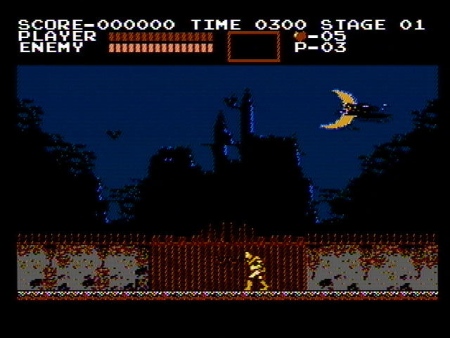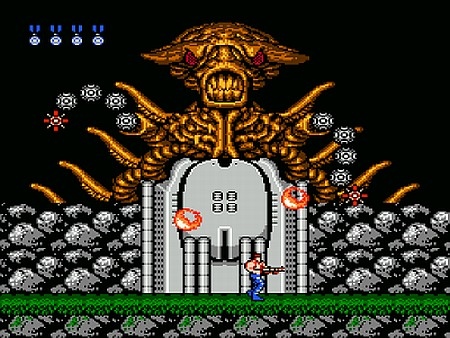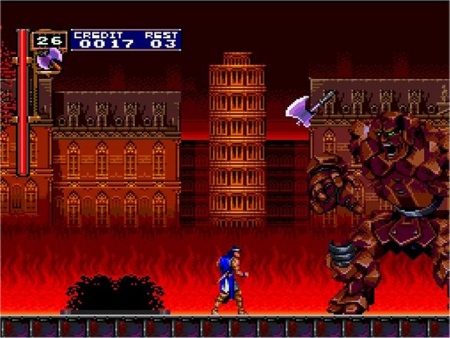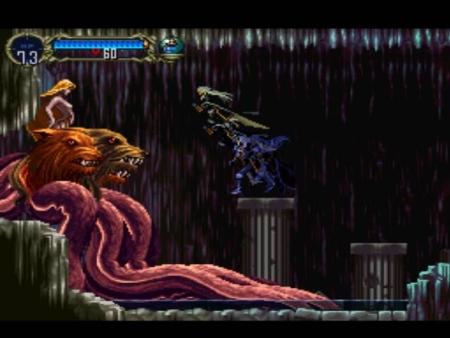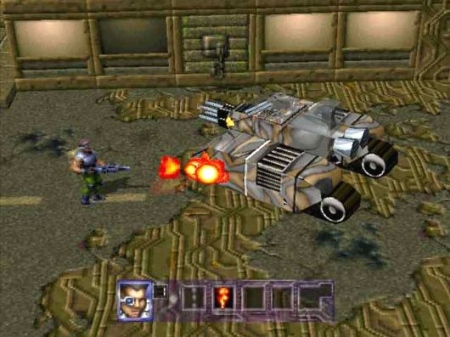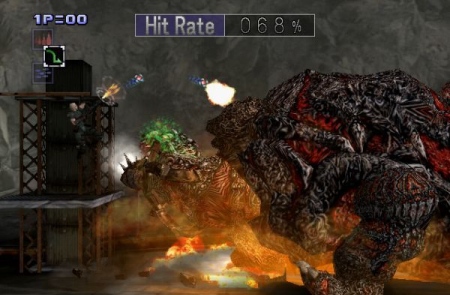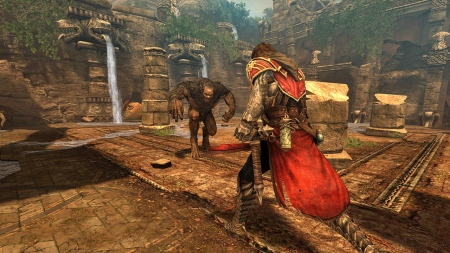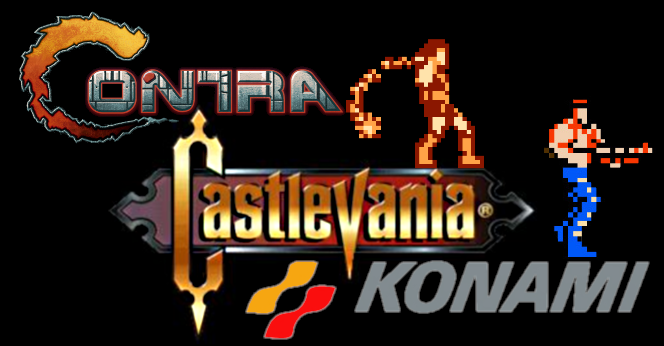
Canonical Case Study: Castlevania and Contra
The sharp crack of a leathery whip echoes through mausoleum halls, the booming gunshots of an automatic rifle thunder across an alien landscape – these are the signature sights and sounds from two of gaming’s most storied franchises, Castlevania and Contra respectively, both now over 25 years old as first developed and published by Konami.
These hallowed series made their initial mainstream console appearances as cartridges for the 8-bit Nintendo Entertainment System (NES), with Castlevania being released in North America in 1987 and Contra in early 1988. The two properties are still going strong, persisting across several different platforms and spanning four different decades so far. Such lasting brand strength offers gamers a unique case study into how a canon successfully strikes a chord with players, even throughout many sequels.
Ambitious Beginnings
The original Castlevania video game was released on the Japanese Family Computer Disk System in 1986, before crossing the ocean on the NES the year after. Contra, meanwhile, was originally an arcade cabinet that was ported to several systems, such as the Commodore 64, ZX-Spectrum, even MS-DOS, along with its NES iteration, which became the most well-recognized.
These two original Konami titles had some commonality: Side-scrolling platforming with varied weapon use and an emphasis on tense action. In fact, at first glance, the two may not even seem all that special; after all, the 8-bit scene was known for its glut of platformers, whether in straight-up genre purism or its popular hack-‘n’-slash and run-‘n’-gun forms, which these two entries somewhat represented.
Fortunately for Konami, the two humble cartridges possessed two defining characteristics that would prove to set them apart from the usual fare: Presentation and gameplay quality. The talented development staff and their diverse skill sets showed up in full force for both releases, with graphics composed of still-vaunted pixel art and soundtracks that sublimely accompanied the on-screen action.
Then there was the gameplay quality, tightly honed to perfection, and representing an alchemical fusion of punishing difficulty level yet undeniable replayability. The extent of their challenge ensured that competitive gamers of the time, and still today, would seek these games as the true tests of the era, yet every aspect of their play showed caring detail tailored toward a singular purpose: Fun. All-out, straight-up, beginning-to-end fun was the obvious goal at hand.
Besides that perhaps-simplistic take, even from a broader narrative point of view, the two properties definitely had some strong ground to stand on. The protagonists in each series are placed in fantastical settings in which they must overcome overwhelming odds in order to defeat evil and emerge as the hero. Is this not the classic formula for a solid plot? Yet, for Contra and Castlevania, could there be more to the story of their success?
Consider: Would Castlevania have been so popular without its distinctive Gothic motif, its perpetual ode to the classic horror tropes of Dracula, Wolfman, Frankenstein’s monster and the like? Perhaps the game just represented a prophetic foreshadowing of the potent popularity of vampire-centric stories, as Twilight would show. More likely, though, is that at such an early period for 8-bit gaming, there was nothing else on the market quite like an arduous, candle-lit haul through medieval-feeling masonry fighting classic monsters and even Death himself. Crafting such an atmospheric, ahead-of-its-time environment was a cunning move by Konami.
Then there is Contra, an adrenaline-rushing, pulse-pounding run-‘n’-gunner that demands militant focus and twitchy thumbs, an alien-slaughtering romp so legendary for its toughness that many still cannot defeat it without resorting to the cheat code that allows the player(s) to begin with 30 lives rather than the default 3. From the jungle to the tundra to the heart of the extraterrestrial enemy, all peripheral elements were sacrificed in order to give a streamlined experience of explosive enjoyment. One hit may kill you, but you can fire in eight different directions; foes endlessly parade into view, but can be mowed down with savage projectile weaponry; bosses are stout, but rely on fixed, pattern-based attacks, etc. The gameplan: Never retreat or stop tapping the B button. Would Contra have been so infamously famous if it were easier or more complex?
Yet in those early days, each property actually had a little difficulty finding their identity. Even Wikipedia says that Castlevania borrowed its candle-hitting mechanic to find items from Super Mario Bros, in which blocks are broken by the character in order to earn points, coins, and power-ups. Also, the version of the original Castlevania video game that was ported to the MSX computer was a bit different: It was simply called Vampire Killer, after the whip in the games, and was based on a more open-ended, less linear form of play, similar to Metroid, and interestingly prescient to steps the franchise would later take across all platforms.
In Contra’s case, that first Nintendo cartridge plays a little differently depending on the region. On the Famicom in Japan, there are actually cutscenes between levels, including an opening scene nearly 90 seconds in length, along with glimpses at an overworld map after each stage. In addition, many of the area backgrounds are animated to some degree, a feature missing from the other releases. Then there is the PAL-region release in Europe, called Probotector, depicting a robot-on-robot war rather than human-on-alien, since a law in Germany at the time made it illegal to depict the murder of a human being in any animated media, which apparently included video games.
Nonetheless, despite whatever obstacles and stumbling blocks were encountered, Konami busted the gates wide open with those two first publications, and suddenly found themselves with a couple of top-shelf hits. The question must have inevitably risen: Where to go from here?
Successful Peaks
Konami wasted no time as a development company: Castlevania and Contra would both see popular sequels on the NES console, and gamers everywhere would be forced to reckon with the production values of what would become among the premiere flagship lines of Nintendo product.
Castlevania, perhaps already having deeply mined the classic-horror tropes, was hasty to experiment. Castlevania II: Simon’s Quest was an oddity, still debated for its merits, included a dedicated video from The Angry Video Game Nerd detailing its strangeness. It was a more open-world sensation, had a much-maligned night-and-day feature, a deeper economic system, and bizarre puzzles that, at times, could seem impossible to solve, especially given the interaction with non-player characters that supposedly would offer hints but often outright lied. To this day, retro gamers the world over can be heard either despising this outing or defending its artistic strokes of visionary risk.
By comparison, the Contra sequel stuck to its guns rather firmly, pun intended. Super C was a rock-and-roll blast that some say is even harder than the original, one factor being that an altered version of the Konami code only offers 10 lives, rather than the boost of 30 savored before. While Contra toyed with levels that posed an over-the-shoulder shooting view, Super C ditched these in favor overhead, top-down combat. In addition, Super C introduced the use of inclines for the series; maybe a minor introduction, but one that served to enhance the overall flow of the stage designs, used right away from the get-go. Hipsters worldwide may even claim to like Super C over Contra in a match of guns a-blazing.
Castlevania III: Dracula’s Curse seemed to self-examine the first two ‘vania entries and tweak them to provide an idealized adventure. In Curse, the player can, at key points, choose which of branching paths to pursue, and at integral moments can even change which character to control, with three newly unveiled slayers at disposal, including the monumental introduction of Alucard, Dracula’s rebellious son. With its gameplay returning to be more like the original, yet offering more gameplay choice without being as overwhelming as the second, multiple endings to try for, and ability variety in the characterizations, Castlevania III offered a redeeming, impressive quest for fans.
By 1992, the “Contra” name was so valuable and vaunted that when Konami obtained the rights to a canceled Japanese game called Arc Hound, they localized it for North America, called it Contra Force, and pushed it onto an unsuspecting market. With its character selection, lack of sci-fi elements, larger character sprites, less platforming emphasis, and war against terrorists rather than aliens, it can hardly be regarded as a true sequel, and is likely more appropriately seen as a historical curiosity.
Nonetheless, the properties were hot, and their heat could hardly hope to be held on the NES machine alone. The Nintendo Game Boy alone got three Castlevania games: Castlevania: The Adventure, a basic formulaic take, albeit sans stairs, with a plot 100 years preceding the original NES title, starring ancestor Christopher Belmont; Castlevania II: Belmont’s Revenge, taking place 15 years after The Adventure, adding sub-weapons missing from the first GB title, along with a rather dark plot in which Dracula kidnaps Christopher’s son and turns him into a demon; and Castlevania Legends, a Super Game Boy-enhanced cartridge with a female protagonist, Sonia Belmont, in a game that would take the first slot on the canon timeline until the later Lament of Innocence.
That is not even counting the spin-off game Kid Dracula that was also released on Game Boy, or obscure cast-offs like Haunted Castles in the arcades. But it was within the 16-bit realm where Castlevania would truly start to flex its muscles. While Super Castlevania IV just took the original Castlevania game, reskinned it for updated graphics, remixed the music, added five levels, and strengthened the whiplay, it hit mass acclaim quickly as proof-of-concept that the franchise fit well for technological advancements. This was also shown in the lone series release on Sega Genesis, Castlevania: Bloodlines, sporting some outstanding special effects, a surprising amount of gory violence for the time and its seemingly family-friendly rating, and truly innovative challenges.
One other notable Castlevania release at this time was Castlevania: Rondo Of Blood, released in Japan on the PC Engine, and would later be re-released on the SNES as Castlevania: Dracula X, though with differing presentational touches, and on the PlayStation Portable and Wii’s Virtual Console in 2008-2010. Amid all the numerous Castlevania releases that would come to exist, Rondo is frequently cited as among the very best for its perfected control, imaginative artistic stylings, and overall fond faithfulness to the source universe.
But while Castlevania was at least sticking to its tried-and-true side-scrolling action as the series blossomed and bloomed, Contra was going for the jugular and testing its limits. Operation C was a Game Boy title that not only offered automatic fire for the first time for just holding down the B button, removing the need for the machine gun, but also introduced homing missiles as a weapon. While it was otherwise mostly a retread of Super C in its staging, these tweaks would prove to be fairly prescient in nature.
Full-throttle action arrived on-scene with the advent of Contra III: The Alien Wars on the 16-bit Super Nintendo Entertainment System (SNES) console. Automatic fire was intact, homing missiles were available, bombs could be accrued, temporarily shields were up for grabs, the explosions were bigger, walls were climbed, buildings crumbled, stuff caught on fire, the bosses were more disgusting, and the whole package just felt crunchier. And that was all before the second level, where the Mode 7 graphics were on stunning display in an overhead portion with rotating visuals at a silky-smooth clip. Granted, many players would come to find this stage to be an annoyance amid the rest, but it was certainly an intriguing spectacle.
Yet if all that was not enough, Contra: Hard Corps for Sega Genesis should have satisfied even the bloodlustiest of 16-bit Contra fans. This game was, indeed, hardcore, as it sacrificed overhead stages but threw in switchable arsenals, sliding, and character selections that included an android and a wolf-like cybernetic humanoid. The word “damn” even makes noteworthy appearances, packing an edgy punch for the era.
Konami had clenched a foothold outside of Nintendo’s systems. As a third-party developer and publisher, their team was in place to make great games across any platform they saw fit. In a way, their 16-bit Castlevania and Contra efforts can be seen as a microcosm of the console wars of the period. Debates among the respective camps could be launched: Would Super Nintendo’s palette shine brighter? Did Sega’s audio provide meatier sound effects? Which could pump out more explosions on-screen at one time, how quickly could they fire projectile rounds, which could synthesize voice effects at a higher fidelity, and how dynamically could environmental components be incorporated?
Cross-console comparisons aside, Konami seemed to be knocking every attempt out of the park with their multi-generational success across the Castlevania and Contra franchises. Their cartridges were handing gamers endless hours of intense play, as each title seemed to hone their development chops further and further. Quality was cresting at an awe-inspiring peak. At this apex juncture, what factors could possibly slow these two franchise juggernauts down?
Growing Pains
Just as the two blockbuster franchises were forging ahead, so too was the industry itself, along with the hardware specifications of its consoles. The 64-bit era was about to hatch; and with it, polygon-rendered worlds that promised players a deeper three-dimensional experience and revolutionary new ways to game.
The 64-bit opportunity was crucial: Rival third-party developers such as Capcom, Rare, and Square were staking their reputations on once-in-a-lifetime games. The market for skilled artists who were adept at professionally manipulating angles and textured surfaces was at a fervid premium. High concepts like “retro gaming,” “online multiplayer,” and a future beyond bits and cartridges were gradually being established.
Adding fuel to the fire of a thriving gaming culture was the dichotomy of some characters fading away while others threatened to grab the spotlight. Would Nintendo’s Starfox and Earthbound properties survive the jump to 3D? How would Final Fantasy fare on a three-disc epic? What were Sega’s plans for Sonic the Hedgehog? Would Capcom continue to bleed Mega Man for all they could, or shove entrants like Resident Evil into their premiere offerings? We may be able to look back with the blessing of 20/20 hindsight and observe where companies went wrong or right, but at the time, conjecture was foggy and hopes ran rampant. Castlevania and Contra would have to make a big splash if they wanted to stay in the pond.
In 1997, the world fell prey to Castlevania: Symphony of the Night on the original PlayStation console. It was a two-dimensional, sprite-animated video game, taking the Castlevania standard and pushing it up a notch. Despite all others’ proclivity toward the third dimension, this 2D gem would prove to be, by the reckoning of some, the glorious highlight of the canon. Its more open-world feel, similar to then-era and prior Metroid games, gave rise to the term “Metroidvania” to describe similar titles. Magazines called it among the best video games ever made; especially Electronic Gaming Monthly, who would not only call it the PlayStation Game Of The Year, but even the number one best PS1 game of all time.
Konami dipped its Castlevania brand into the Nintendo 64 pot as well, first with the provocatively named Castlevania in 1999. Although it officially had no “64” in the title, it would go on to be popularly referred to as Castlevania 64, and be considered a solid, worthy, respectable entry in the series. The jump to three dimensions looked like it would succeed, and already later in the year, Castlevania: Legacy of Darkness would also drop on Nintendo’s 64-bit platform. This one, however, was met with mixed reception; some considered its graphics now appearing too clunky, the control too muddled, the impact gone, despite some seeing it as a fond favorite for such flourishes as the chainsaw-brandishing Frankenstein’s monster.
Incredibly, Castlevania Legends was released on the original Game Boy portable in 1999 as well, now representing the third in the franchise on that system, crossing an entire decade, and this one complete with Super Game Boy enhancements. It was fine enough, but Konami kept its portable-gaming trump cards up its sleeves for one more generation. The real issue at the time was the health of the Contra brand.
Perhaps because they were so busy keeping life pumped into the Castlevania run or trying other franchise entries, Konami placed the responsibility for developing Contra games on the PS1 in the hands of Appaloose Interactive. To make a long story short: This ended up being a poor, canon-crippling decision.
Two games resulted: Contra: Legacy of War in 1997, and C: The Contra Adventure in 1998. Despite the introductions of memory card saves, graphics utilizing three dimensions, and fleshing out the plot a bit more, mainstream publications derided both titles, with Adventure popularly going down as the worst game in the series. In stark opposition to the crisply mastered format of the 16-bit sprites and side-scrolling actions, these projects in advancing the franchise were failures by any measure. Contra’s rep, so to speak, was hanging by a thin, fragile thread. Would Konami show Contra any more love or decide to cut it loose for good?
Meanwhile, for many, Castlevania would find its stride on the Game Boy Advance, with a trio of knock-out punches for fans: Circle of the Moon, Harmony of Dissonance, and Aria of Sorrow, in 2001, 2002, and 2003 respectively. Notably, each was a two-dimensional side-scroller, seeming to be poured from the same mold of momentum as previous-generation games. While, inevitably, countless voices have lent their opinions on the GBA threesome, the consensus seems to be that they represent a formidable trio, with Castlevania: Aria of Sorrow representing the perfected jewel that seemed to learn from its two predecessors, and remains to this day a critically acclaimed piece of portable gaming. This presented Konami with a conundrum: Should the third dimension be be explored to a deeper extent, or had they already found their niche vision?
Modern Reinventions
Konami would distance itself from Nintendo’s non-portable systems in the next generation, sticking to the PS2 and, eventually, the Xbox in terms of its Castlevania line. The Gamecube-less tactic worked, as Castlevania: Lament of Innocence and Castlevania: Curse of Darkness were generally regarded as solid games. Even if neither were looked at as AAA discs, except perhaps by the franchise-specific fandom, they represented a clean bill of health for the Belmont clan and their adventuring.
They even nonchalantly continued busting out hits on the Nintendo DS to keep conquering the hand-held realm as well, with Castlevania: Dawn of Sorrow and Castlevania: Portrait of Ruin signifying that the well-tread saga still had room for ingenuity, story impact, and just plain fun. Konami had shown a keen sense of ownership over Castlevania, and made it clear to fans that it was among their most-prized assets. Viability held firm.
So where did that leave Contra? Fortunately, Konami seemed to recognize their Appaloosa folly, as they made a bold move on the PS2: Not only did they take back their first-party development reins, but 2002’s Contra: Shattered Soldier also marked a return to two-dimensional side-scrolling shooting action, like the games of two generations prior. On PS2, this was a rarity, and a risky gambit.
The result was mixed. While it was buzzy and discussion-provoking to put a “retro chic” Contra game onto the market, many reviewers found that it simply did not stand toe-to-toe with its peer releases, despite some admitting it enjoyable. Ultimately, as a video game, it was not awful, but neither did it properly represent the heights attained by the NES original or the 16-bit forays.
Konami gave the PS2 one more shot of Contra with Neo Contra, and it felt like a step backwards: Gone was the traditional 2D, instead bringing 3D back into play yet again, albeit largely in isometric view and alongside a renewed emphasis on boss fights. Aggregately, it ended up being a step down from Shattered Soldier in the eyes of reviewers. At this point, Contra could only be considered a kid brother to Castlevania, and seemed to be a vehicle that was losing steam and, possibly, not worth putting forth any real effort back into.
Promising Futures
And then Contra 4 hit the scene on Nintendo DS in 2007, representing the first portable Contra game in 16 years, and hailed as a potential rebirth for the Contra franchise. The levels scrolled, the guns blasted, and the soul of the original games was kept intact while keeping key implementations from Contra III and Shattered Soldier in play.
But that was not enough: In two curious choices, Contra ReBirth hit WiiWare as a downloadable game in 2009, showing up as an even more retro-friendly iteration of the franchise, and a hit, enough to be considered among the top WiiWare games of the year, if not ever.
Then along came Hard Corps: Uprising, without “Contra” even in the title, available for download on Xbox Live Arcade or the PlayStation Network in 2011. Between the anime stylings of its artwork and nimble use of character movement in conjunction with weaponry, Hard Corps: Uprising is definitely a visibly new direction for the series.
The possibility of Contra returning to the mainstream hype on modern consoles is not entirely nonexistent. However, realistically, Konami had, in its actions, made a resounding statement that Contra has found a target audience among those who are either willing to give it a playthrough as a tribute to its historical leanings, or among those who would be willing to accept some radical retooling.
As for Castlevania, the vaunted House Of ‘Vania actually had a misstep with Castlevania: Judgment on the Nintendo Wii in 2009. This was a fighting game that incorporated motion controls, and no more should have to be said, as the result is both a travesty to competitive fighting games and legitimate Castlevania games.
Yet in late 2010, on Xbox 360 and PS3 consoles, Castlevania: Lords of Shadow was released. This was the all-hands-on-deck, Hail Mary, eggs-in-one-basket, winner-take-all title – a no-holds-barred, all-out, balls-to-the-wall, completely modern re-entry for the franchise that Konami was putting its full development resources and clout behind.
Not only was it among the most anticipated video games of its time throughout its creation, but it was able to deliver on expectations by giving players a Gothic, shadowy, story-rich good time. Fans applauded, new series observers were forced to reckon with the name, and the only detractors were those who saw such a new-fangled 3D disc as some sort of departure for the franchise. In reality, not only was it a plain-good action game, but it would hint at a sequel, renewing the cycle of anticipation for a new legion of fandom.
As for Contra, a game has been confirmed in development for the Nintendo 3DS at press time. Along with the success of Castlevania: Lords of Shadows, we can draw a couple of fun conclusions. Firstly, that Konami is not yet done, and perhaps not even within range of being done, with two of its most-beloved canon. This is great news for gamers seeking to continue being part of a culture that matches old-school homage with new-school fanciness.
Finally, in the broader framework of electronic gaming, we have the privilege of witnessing the continued evolution of two franchises with strong individual identities under a developer seemingly committed to seeing them continue on in some fashion. Whether from their successes or their falterings, many programmers, visionaries, indie developers, and others could learn much from the stories of Castlevania and Contra. Sometimes the crack of a whip or a booming gunshot is all the inspiration you need to launch something that will touch the lives of millions and give the gift of entertainment for decades to come.
